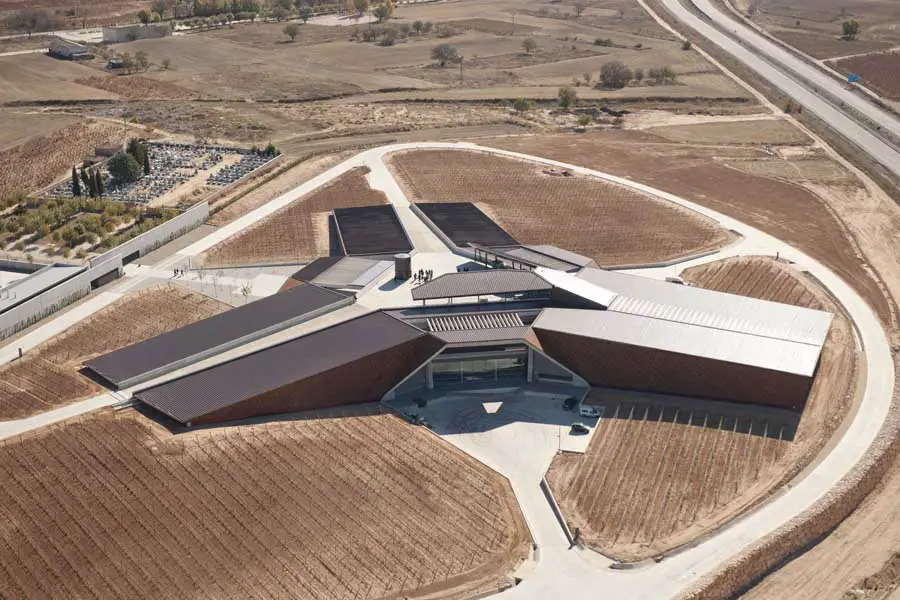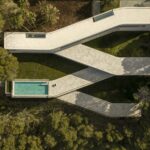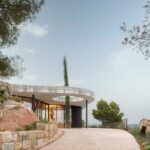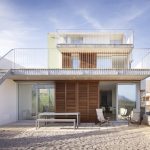Faustino Winery, Ribera del Duero architecture, Bodegas Portia design news
Faustino Winery : Ribera del Duero Building
Faustino Winery, Ribera del Duero, Spain design by Foster + Partners.
post updated 2 August 2024
Location: Ribera del Duero, Spain
Faustino winery opens in Spain
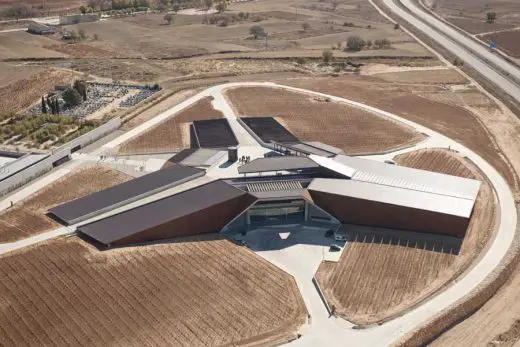
photo : Nigel Young_Foster + Partners
1 Nov 2010
Faustino Winery Spain
Bodegas Portia is a new winery for the Faustino Group in the Ribera del Duero, one of Spain’s foremost wine-producing regions. The project is Foster + Partners first winery and was an opportunity to look afresh at the building type, using the natural topography of the site to aid the winemaking process and create the optimum working conditions, while reducing the building’s energy demands and its visual impact on the landscape.
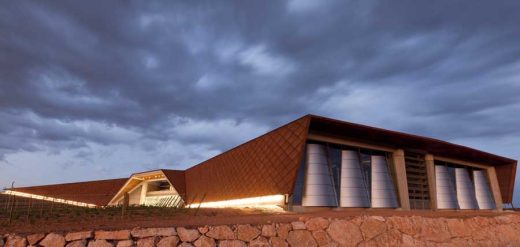
Faustino Winery picture : Nigel Young_Foster + Partners
The 12,500 square-metre facility has a production capacity of one million bottles per year. The building’s trefoil design expresses the three main stages of production: fermentation in steel vats; ageing in oak barrels; and finally, ageing in bottles. These are controlled by an operations hub at the core.
The wings containing the barrels and bottle cellar are partly embedded into the ground to produce the most favourable environmental conditions for ageing the wine, while the fermentation wing is exposed, allowing carbon dioxide to be released. A road rises to the roof of the building, where the harvested grapes are delivered straight into the hopper: the winery is designed to take advantage of the sloping terrain, using gravity to aid movement of the grapes within the building, maximising efficiency and minimising damage to the grapes. The concrete structure is clad in shingles of Corten steel.
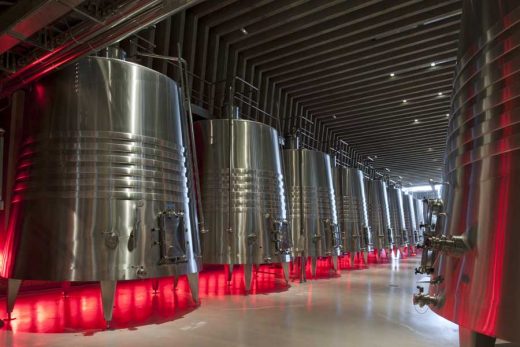
Faustino Winery picture : Nigel Young_Foster + Partners
The site in the Ribera del Duero, approximately 150 kilometres north of Madrid, has extremely cold winters, as well as hot summers with limited rainfall. The deep overhang of the roof canopy provides shade and the building is designed to regulate the internal temperatures, at the same time as reducing energy demand. By partly embedding the building within the landscape, its visual impact is minimised and the passive environmental benefits are maximised – the roof incorporates photovoltaic cells and the thermal mass of the concrete structure helps to control interior temperatures.
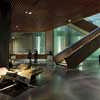
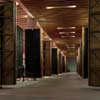

Faustino Winery pictures : Nigel Young_Foster + Partners
At the heart of the winery a raised public gallery extends into glazed mezzanine areas, which project deep into each wing, allowing visitors to enjoy elevated views of the different processes. Between the wings is a light-filled public reception and administration area, where extensive terraces and pools of water overlook the vineyards. Lined with deep-stained old wine barrel slats, the public areas are designed to evoke the rich tradition of winemaking in the region.
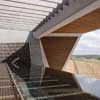
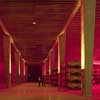
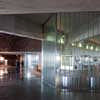
Faustino Winery pictures : Nigel Young_Foster + Partners
Lord Foster said:
Bodegas Portia is our first winery, so we had no preconceptions about how it should work. It was an opportunity to start from first principles – to examine the different stages of wine production and to try to create the ideal conditions for them to unfold. The wine was the starting point, as well as the beautiful setting in Ribera del Duero. Using materials that draw on the region’s winemaking traditions, with public spaces open to the landscape, will enhance the visitor experience.”
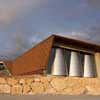
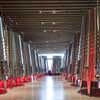
Faustino Winery pictures : Nigel Young_Foster + Partners
Faustino Winery, Ribera del Duero images / information from Foster + Partners
Faustino Winery, Ribera del Duero
2007-10
Foster + Partners
24 May 2007
Designs for a new winery for the Faustino Group launched
Foster + Partners have unveiled designs for a new winery for the Faustino Group, 150km north of Madrid in the Ribera del Duero, one of Spain’s foremost wine-producing regions. Form follows function to striking effect, with the complex processes rationalised to create the optimum conditions for wine production. The material palette of oak, steel and glass relates to the production of wine, itself. Visible from one of the main arteries in the country that links Madrid to Bilbao; the winery will be a new symbol for the group, establishing their new brand, Bodegas Portia.
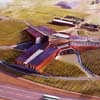

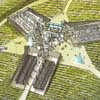
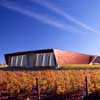
Faustino Winery images : Foster + Partners
Reminiscent of the naturally undulating topography of the site, a road climbs to the roof of the building, enabling the harvested grapes to be poured straight down into the hopper, where the wine production process begins. The building’s unusual trefoil design is the logical result of a rationalisation of the wine making process into its three core functions. Using gravity to aid movement of the wine within the building, the circulation between the functions is seamless – maximising efficiency and minimising damage to the grapes and wine at their various stages of preparation.
The different needs for each stage – the fermentation in steel vats, ageing in oak barrels and finally, ageing in bottles – dictate the three distinct volumes of the building which are controlled by an operations hub at the core. The wings which house the barrels and bottle cellar are partly sunken below ground, providing the most favourable conditions for ageing the wine, while the fermentation wing is exposed, allowing carbon dioxide to be released.
Partly buried within the landscape, the visible impact of the building is reduced and the passive environmental benefits are maximised, as the concrete structure uses thermal mass to control the internal atmosphere. The building is clad in tiles of earth-toned Corten steel, which further enhances a sense of harmony with the dramatic landscape. The design also incorporates photovoltaic cells on the roof, thus lessening the environmental impact. A slim line of day-light in the wings of the vast spaces of the winery delineates the ground level, to aid orientation for both visitors and employees.
The main visitor facilities are located at the heart of the building, overlooking the operations hub with access to the public areas on glazed mezzanine levels extending to each wing and to the wine tasting in the café and restaurant. Lined with deep-stained old wine barrel slats, they are evocative of the rich tradition of winemaking in the region. The winery will open in time to process the first harvest of 1.2m kilos of grapes in Spring 2008.
Faustino Winery design : Foster + Partners
Faustino Winery images / information from Foster + Partners
Location: Bodegas Portia, Ribera del Duero, Spain, southwestern Europe
Architecture in Spain
Spanish Architecture Designs – chronological list
Spanish Architecture – Selection
, Barcelona
Foster + Partners
Nou Camp Stadium
Rogers Stirk Harbour Partners
Bodegas Protos : Stirling Prize Nominee 2009
America’s Cup Pavilion Valencia : Edificio Veles e Vents
David Chipperfield Architects with b720 (architects, Barcelona)
Americas Cup Pavilion Valencia
Architecture Design
Contemporary Building Designs – recent architectural selection from e-architect below:
Comments / photos for the Faustino Winery Architecture design by Foster + Partners Architects, UK, page welcome.

